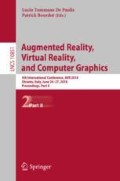Abstract
Technology could sensitize end-users to preservation of cultural heritage while stimulating more interest based on a greater involvement. Our approach to this goal is based on a novel gamification and story-telling based on scientific foundations. At the same time, this application can offer the pro-user an interactive visualization suitable to study and verify new theories about the artifacts both on their current state and on its 3D reconstruction, but, at the same time, design a workflow capable to integrate different optimization techniques to adjust data depending on different scenarios. This leads to a unified system able to adapt itself to external requirements in a semi-automatic fashion. Finally, new ways of playful interaction, based on simple mathematical operations, were investigated.
The second-named author is partially supported by MIUR Excellence Department Project funds, awarded MIUR to the Department of Mathematics, University of Rome Tor Vergata, CUP E83C18000100006.
Access this chapter
Tax calculation will be finalised at checkout
Purchases are for personal use only
Notes
- 1.
This aspect is particularly important for catacombs. A visitor with walking disabilities will not be able to visit a catacomb not equipped with suitable adjustments of the walking path. but these adjustments are often incompatible with the preservation of the archaeological area, or at least very difficult. Virtual Reality allows these persons to experience a full immersion into the archaeological site, with natural interaction.
References
de Freitas, S.: What-can-Gamification-add-to-cultural-heritage.pdf. http://www.digitalmeetsculture.net/wp-content/uploads/2013/07/Sara_de_Freitas_What-can-Gamification-add-to-cultural-heritage.pdf
Hartley, R., Zisserman, A.: Multiple View Geometry in Computer Vision, 2nd edn. Cambridge University Press, Cambridge (2004)
Mallison, H., Wings, O.: Photogrammetry in paleontology - a practical guide. J. Paleontol. Tech. 12, 1–31 (2014)
Author information
Authors and Affiliations
Corresponding author
Editor information
Editors and Affiliations
Rights and permissions
Copyright information
© 2018 Springer International Publishing AG, part of Springer Nature
About this paper
Cite this paper
Bazzurri, F., Picardello, M.A. (2018). Optimization Techniques for Photogrammetry Applied to Cultural Heritage and the Action of Transformation Groups. In: De Paolis, L., Bourdot, P. (eds) Augmented Reality, Virtual Reality, and Computer Graphics. AVR 2018. Lecture Notes in Computer Science(), vol 10851. Springer, Cham. https://doi.org/10.1007/978-3-319-95282-6_25
Download citation
DOI: https://doi.org/10.1007/978-3-319-95282-6_25
Published:
Publisher Name: Springer, Cham
Print ISBN: 978-3-319-95281-9
Online ISBN: 978-3-319-95282-6
eBook Packages: Computer ScienceComputer Science (R0)

